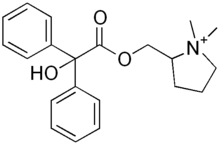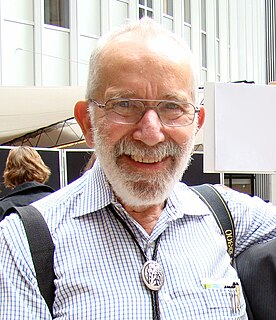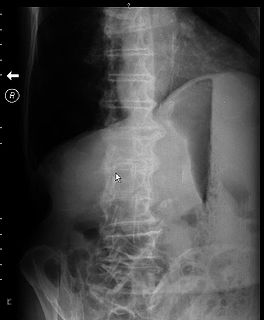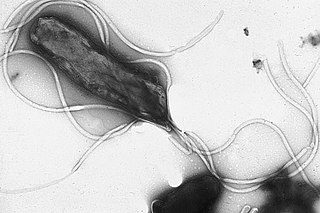 | |
| Clinical data | |
|---|---|
| ATC code | |
| Identifiers | |
| |
| CAS Number | |
| PubChem CID | |
| ChemSpider | |
| UNII | |
| Chemical and physical data | |
| Formula | C21H26NO3+ |
| Molar mass | 340.443 g·mol−1 |
| 3D model (JSmol) | |
| |
| |
| (verify) | |
Poldine is an antimuscarinic [1] that is used to treat peptic ulcers. [2]
 | |
| Clinical data | |
|---|---|
| ATC code | |
| Identifiers | |
| |
| CAS Number | |
| PubChem CID | |
| ChemSpider | |
| UNII | |
| Chemical and physical data | |
| Formula | C21H26NO3+ |
| Molar mass | 340.443 g·mol−1 |
| 3D model (JSmol) | |
| |
| |
| (verify) | |
Poldine is an antimuscarinic [1] that is used to treat peptic ulcers. [2]

Peptic ulcer disease (PUD) is a break in the inner lining of the stomach, the first part of the small intestine, or sometimes the lower esophagus. An ulcer in the stomach is called a gastric ulcer, while one in the first part of the intestines is a duodenal ulcer. The most common symptoms of a duodenal ulcer are waking at night with upper abdominal pain and upper abdominal pain that improves with eating. With a gastric ulcer, the pain may worsen with eating. The pain is often described as a burning or dull ache. Other symptoms include belching, vomiting, weight loss, or poor appetite. About a third of older people have no symptoms. Complications may include bleeding, perforation, and blockage of the stomach. Bleeding occurs in as many as 15% of cases.

Zollinger–Ellison syndrome is a disease in which tumors cause the stomach to produce too much acid, resulting in peptic ulcers. Symptoms include abdominal pain and diarrhea.

Barry James Marshall is an Australian physician, Nobel Prize Laureate in Physiology or Medicine, Professor of Clinical Microbiology and Co-Director of the Marshall Centre at the University of Western Australia. Marshall and Robin Warren showed that the bacterium Helicobacter pylori plays a major role in causing many peptic ulcers, challenging decades of medical doctrine holding that ulcers were caused primarily by stress, spicy foods, and too much acid. This discovery has allowed for a breakthrough in understanding a causative link between Helicobacter pylori infection and stomach cancer.
Melena or melaena refers to the dark black, tarry feces that are associated with upper gastrointestinal bleeding. The black color and characteristic strong odor are caused by hemoglobin in the blood being altered by digestive enzymes and intestinal bacteria.

John Robin Warren is an Australian pathologist, Nobel Laureate and researcher who is credited with the 1979 re-discovery of the bacterium Helicobacter pylori, together with Barry Marshall. The duo proved to the medical community that the bacterium Helicobacter pylori is the cause of most peptic ulcers.

A gastroenterostomy is the surgical creation of a connection between the stomach and the jejunum. The operation can sometimes be performed at the same time as a partial gastrectomy. Gastroenterostomy was in the past typically performed to treat peptic ulcers, but today it is usually carried out to enable food to pass directly to the middle section of the small intestine when it is necessary to bypass the first section because of duodenal damage. The procedure is still being used to treat gastroparesis that is refractory to other treatments, but it is now rarely used to treat peptic ulcers because most cases thereof are bacterial in nature and there are many new drugs available to treat the gastric reflux often experienced with peptic ulcer disease. Reported cure rates for H. pylori infection range from 70% to 90% after antibiotic treatment.

Sucralfate, sold under various brand names, is a medication used to treat stomach ulcers, gastroesophageal reflux disease (GERD), radiation proctitis, and stomach inflammation and to prevent stress ulcers. Its usefulness in people infected by H. pylori is limited. It is used by mouth(for upper GIT ulcers) and rectally(for radiation proctitis).
Peptic is an adjective that refers to any part of the body that normally has an acidic lumen, or is related to or promotes digestion. 'Peptic' is medical and veterinary terminology, most often used in the context of humans.
In medicine, Valentino's syndrome is pain presenting in the right lower quadrant of the abdomen caused by a duodenal ulcer with perforation through the retroperitoneum.

A vagotomy is a surgical procedure that involves removing part of the vagus nerve.

Enprostil is a synthetic prostaglandin designed to resemble dinoprostone. Enprostil was found to be a highly potent inhibitor of gastric HCl secretion. It is an analog of prostaglandin E2 but unlike this prostaglandin, which binds to and activates all four cellular receptors viz., EP1, EP2, EP3, and EP4 receptors, enprostil is a more selective receptor agonist in that it binds to and activates primarily the EP3 receptor. Consequently, enprostil is expected to have a narrower range of actions that may avoid some of the unwanted side-effects and toxicities of prostaglandin E2. A prospective multicenter randomized controlled trial conducted in Japan found combining enprostil with cimetidine was more effective than cimetidine alone in treating gastric ulcer.

Gastric outlet obstruction (GOO) is a medical condition where there is an obstruction at the level of the pylorus, which is the outlet of the stomach. Individuals with gastric outlet obstruction will often have recurrent vomiting of food that has accumulated in the stomach, but which cannot pass into the small intestine due to the obstruction. The stomach often dilates to accommodate food intake and secretions. Causes of gastric outlet obstruction include both benign causes, as well as malignant causes, such as gastric cancer.

This is a timeline of the events relating to the discovery that peptic ulcer disease and some cancers are caused by H. pylori. In 2005, Barry Marshall and Robin Warren were awarded the Nobel Prize in Physiology or Medicine for their discovery that peptic ulcer disease (PUD) was primarily caused by Helicobacter pylori, a bacterium with affinity for acidic environments, such as the stomach. As a result, PUD that is associated with H. pylori is currently treated with antibiotics used to eradicate the infection. For decades prior to their discovery, it was widely believed that PUD was caused by excess acid in the stomach. During this time, acid control was the primary method of treatment for PUD, to only partial success. Among other effects, it is now known that acid suppression alters the stomach milieu to make it less amenable to H. pylori infection.

A perforated ulcer is a condition in which an untreated ulcer has burned through the mucosal wall in a segment of the gastrointestinal tract allowing gastric contents to leak into the abdominal cavity.

Clidinium bromide (INN) is an anticholinergic drug. It may help symptoms of cramping and abdominal/stomach pain by decreasing stomach acid, and slowing the intestines. It is commonly prescribed in combination with chlordiazepoxide using the brand name Normaxin.

Acemetacin is a non-steroidal anti-inflammatory drug (NSAID) used for the treatment of osteoarthritis, rheumatoid arthritis, lower back pain, and relieving post-operative pain. It is manufactured by Merck KGaA under the tradename Emflex, and is available in the UK and other countries as a prescription-only drug.
An ulcer is a discontinuity or break in a bodily membrane that impedes normal function of the affected organ. According to Robins's pathology, "ulcer is the breach of the continuity of skin, epithelium or mucous membrane caused by sloughing out of inflamed necrotic tissue." Common forms of ulcers recognized in medicine include:

Octatropine methylbromide (INN) or anisotropine methylbromide (USAN), trade names Valpin, Endovalpin, Lytispasm and others, is a muscarinic antagonist and antispasmodic. It was introduced to the U.S. market in 1963 as an adjunct in the treatment of peptic ulcer, and promoted as being more specific to the gastrointestinal tract than other anticholinergics, although its selectivity was questioned in later studies.

Penthienate is an anticholinergic and has actions similar to atropine. It reduces gastric motility and secretion and is used for the treatment of peptic ulcer and dyspepsia.

Acetoxolone is a drug used for peptic ulcer and gastroesophageal reflux disease. It is an acetyl derivative of glycyrrhetinic acid.